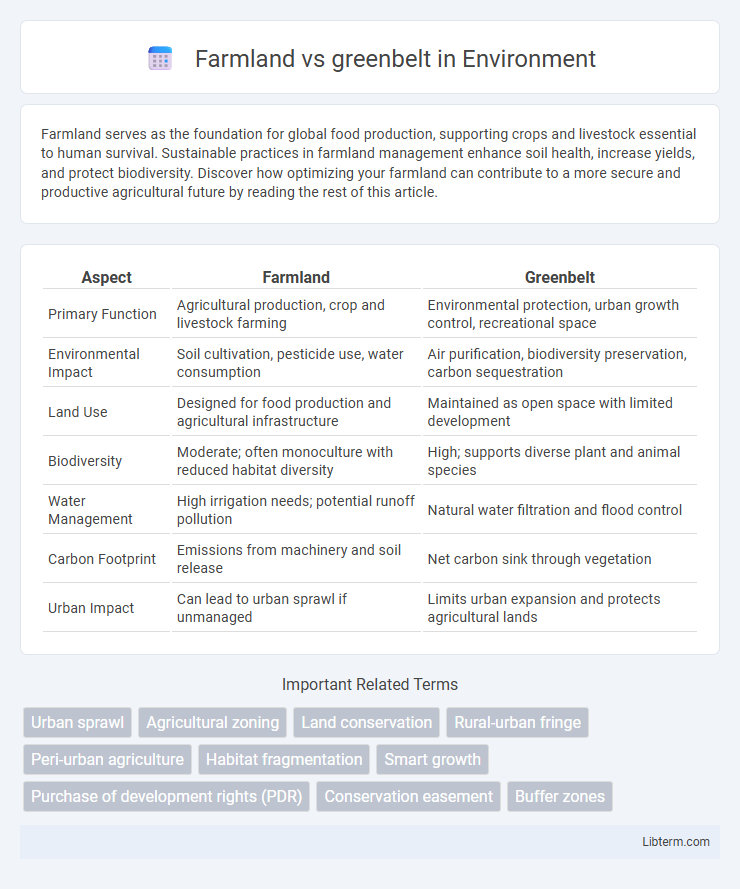Farmland serves as the foundation for global food production, supporting crops and livestock essential to human survival. Sustainable practices in farmland management enhance soil health, increase yields, and protect biodiversity. Discover how optimizing your farmland can contribute to a more secure and productive agricultural future by reading the rest of this article.
Table of Comparison
| Aspect | Farmland | Greenbelt |
|---|---|---|
| Primary Function | Agricultural production, crop and livestock farming | Environmental protection, urban growth control, recreational space |
| Environmental Impact | Soil cultivation, pesticide use, water consumption | Air purification, biodiversity preservation, carbon sequestration |
| Land Use | Designed for food production and agricultural infrastructure | Maintained as open space with limited development |
| Biodiversity | Moderate; often monoculture with reduced habitat diversity | High; supports diverse plant and animal species |
| Water Management | High irrigation needs; potential runoff pollution | Natural water filtration and flood control |
| Carbon Footprint | Emissions from machinery and soil release | Net carbon sink through vegetation |
| Urban Impact | Can lead to urban sprawl if unmanaged | Limits urban expansion and protects agricultural lands |
Understanding Farmland: Definition and Importance
Farmland refers to agricultural land specifically used for growing crops and raising livestock, playing a crucial role in food production and sustaining rural economies. Its preservation ensures biodiversity, soil health, and the availability of local food resources, making it vital for ecological balance and food security. Unlike greenbelts, which are designated zones to limit urban sprawl and protect natural landscapes, farmland is dedicated to productive farming activities essential for long-term agricultural sustainability.
What Is a Greenbelt? Key Characteristics
A greenbelt is a designated area of open land surrounding urban regions, primarily intended to limit urban sprawl and preserve natural ecosystems. Key characteristics include strict land-use regulations that restrict construction and promote environmental conservation, maintaining biodiversity and recreational spaces. Unlike farmland, greenbelts prioritize ecological balance and sustainable urban development over agricultural productivity.
Historical Context: Farmland and Greenbelt Development
Farmland has historically been the backbone of agricultural economies, preserving open space for crop cultivation and rural livelihoods. Greenbelt development emerged in the 20th century as a planning strategy to contain urban sprawl, protect natural landscapes, and maintain ecological balance around cities. The contrast highlights farmland's role in food production versus greenbelts' focus on environmental conservation and urban growth control.
Environmental Impact: Farmland vs Greenbelt
Farmland supports biodiversity by providing habitats for various species and contributes to carbon sequestration through crop cultivation and soil management. Greenbelts offer critical ecosystem services such as air purification, temperature regulation, and wildlife corridors, enhancing urban sustainability. While farmland may produce pollution from fertilizers and pesticides, greenbelts help mitigate urban sprawl and reduce greenhouse gas emissions by preserving natural vegetation.
Urban Expansion: Challenges and Opportunities
Urban expansion often leads to the conversion of fertile farmland into greenbelt areas, creating conflicts between agricultural preservation and urban development needs. Balancing farmland protection with greenbelt designation involves addressing challenges such as housing demand, infrastructure growth, and ecosystem services preservation. Opportunities arise from smart growth strategies that integrate farmland conservation with controlled urban sprawl, enhancing food security and sustainable land management.
Economic Value: Agriculture vs Conservation
Farmland offers significant economic value through crop production, job creation, and contributions to local and national food supply chains, supporting long-term agricultural sustainability. Greenbelt areas enhance property values, attract tourism, and provide ecosystem services like carbon sequestration and water filtration, which reduce municipal costs related to pollution and climate mitigation. Balancing agriculture and conservation ensures economic resilience by combining direct revenue from farming with the indirect financial benefits of preserved natural landscapes.
Policy Perspectives: Zoning and Land Use Regulations
Zoning and land use regulations critically shape the balance between farmland preservation and greenbelt designation, with policymakers often prioritizing agricultural viability or urban containment based on regional development goals. Farmland zoning typically restricts development to protect agricultural productivity, while greenbelt policies enforce strict limits on urban expansion to maintain open space and ecological functions. The interplay of incentives, such as tax benefits for farmland conservation or restrictions on non-agricultural construction in greenbelt areas, reflects diverse policy approaches aimed at sustainable land management and controlling sprawl.
Biodiversity Considerations in Farmland and Greenbelts
Greenbelts serve as critical buffers protecting biodiversity by preserving natural habitats and connecting fragmented ecosystems, which supports wildlife corridors and a diverse range of plant and animal species. Farmland, though often monocultured, can enhance biodiversity through agroecological practices such as crop rotation, hedgerows, and cover cropping that provide habitats and resources for pollinators and beneficial insects. Effective biodiversity conservation requires integrating greenbelt preservation with sustainable farmland management to maintain ecosystem services and promote species diversity.
Sustainable Development: Balancing Growth and Preservation
Greenbelt areas serve as essential buffers that prevent urban sprawl and protect farmland from excessive development, ensuring long-term agricultural productivity and ecosystem health. Sustainable development strategies prioritize the integration of farmland preservation with controlled urban growth to maintain biodiversity, reduce carbon footprints, and support local food systems. Effective land-use planning harmonizes economic expansion and environmental conservation, promoting resilient communities and safeguarding green spaces for future generations.
Future Outlook: Trends in Farmland and Greenbelt Management
Trends in farmland and greenbelt management emphasize sustainable practices to balance agricultural productivity with environmental conservation. Advancements in precision agriculture and smart land-use policies are driving efficient farmland use while protecting greenbelt areas from urban sprawl. Future outlooks predict increased integration of greenbelt zones as ecological buffers enhancing biodiversity and climate resilience.
Farmland Infographic

 libterm.com
libterm.com